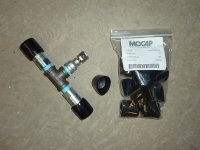Industrial Toys
Super Star Member
- Joined
- Feb 25, 2008
- Messages
- 16,742
- Location
- Ontario Canada
- Tractor
- Kubota R510 Wheel Loader + Cab and backhoe, JD 6200 Open Station, Cushman 6150, 4x4, ten foot 56 hp Kubota diesel hydraulic wing mower, Steiner 430 Diesel Max, Kawasaki Diesel Mule, JD 4x2 Electric Gator
My guess is, a coupler that "weeps" won't have connect/disconnect issues.
My JD 6200 has OEM hand operated, probably Ball valves on the loader aux circuit just behind the two female pioneer couplings. These valves are "supposed to relieve pressure" and have a small hole in the valve body. I have never seen a drop of fluid come out of these holes, and despite the circuit being electric, that you can't activate when the machine is not running, I have never had an issue with pressure. This has always been a mystery to me.
My JD 6200 has OEM hand operated, probably Ball valves on the loader aux circuit just behind the two female pioneer couplings. These valves are "supposed to relieve pressure" and have a small hole in the valve body. I have never seen a drop of fluid come out of these holes, and despite the circuit being electric, that you can't activate when the machine is not running, I have never had an issue with pressure. This has always been a mystery to me.

